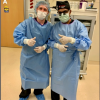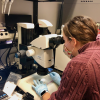The mouse eye is an important genetic model for the translational study of human ophthalmic disease. Blinding diseases in humans, such as macular degeneration, photoreceptor degeneration, cataract, glaucoma, retinoblastoma, and diabetic retinopathy can be recapitulated in transgenic mice. Our team has extensive microsurgical experience with eyes, and we develop and share surgical methods for preclinical research that tests therapies we hope will eventually be used for humans. All studies are conducted in accordance with the ARVO Statement for Use of Animals in Ophthalmic and Vision Research.
Projects
Evsiceration of the mouse retina and vitreous
This surgical technique illustrates evisceration of the vitreous, retina, and lens from the mouse eye, separation by centrifugation, and characterization with protein assays
 Subretinal Injections in the Mouse Eye
Subretinal Injections in the Mouse Eye
This surgical technique illustrates the injection of gene therapy vectors and stem cells into the subretinal space of the mouse eye.
Mouse Eye Enucleation
This surgical technique illustrates removal of the mouse eye for high-thoughput phenotyping.
Mouse Eye Enucleation for Remote High-throughput Phenotyping
News
 A New Method to Test Drug Implants in Mouse Eyes
A New Method to Test Drug Implants in Mouse Eyes
Palo Alto, CA — In the operating room and clinic, Vinit Mahajan M.D., Ph.D., Stanford Ophthalmology vice chair for research and ChEM-H fellow, uses ocular drug implants (ODIs) to safely deliver steroids into the eye to treat a range of e
 Exercise Improves Retinal Health
Exercise Improves Retinal Health
Palo Alto, CA —News outlets, fitness magazines, and health bloggers churn out hundreds of articles on the health benefits of exercise. And most people can tell you that exercise is an important factor in warding off heart disease, diabetes, cancer, and depression.



